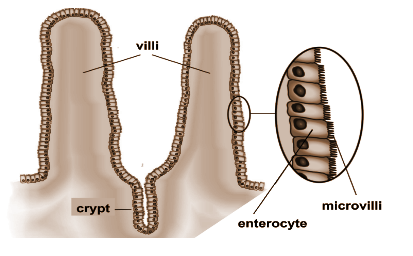
How is the structure of a villi in the small intestine related to its function?
Answer
453.6k+ views
Hint: The small intestine is also known as small bowel and it is a part of the Gastrointestinal tract. It is the organ where the majority of the absorption of minerals and nutrients from the food we eat takes place.
Complete answer:
Villi are vascular projections present in the small intestine projecting into the intestinal cavity
Each villus has many microvilli projecting from its epithelial surface. Villi are specialised for absorption and have very thin walls which are single cell in thickness. They have a rich blood supply to keep a concentration gradient.
The villi of the intestine moves in swaying, contracting motions. These movements increase the flow of blood and lymph and enhance absorption. The villi number about 10 to 40 per square millimetre (6,000 to 25,000 per square inch) of tissue. Digestive enzymes are present on the villi surface for digestion. Villus capillaries collect amino acids and simple sugars taken up by the villi into the bloodstream.
This specific and elaborate structure of the villi helps in increasing the surface area of the membrane. Important villous membranes include the placenta and the mucous-membrane coating of the small intestine.The villi of the small intestine, greatly increasing the surface area for food absorption and adding digestive secretions. An increased absorptive area is useful because digested nutrients exceptionally and efficiently absorb nutrients from the lumen.

Note: Every villus has a focal centre made out of one artery and one vein, a strand of muscle, a midway found lymphatic capillary (lacteal), and connective tissue that adds support to the structures. The blood vessels transport proteins and carbohydrates absorbed by the cells of the villi, while the lacteal eliminates emulsified fat.
Complete answer:
Villi are vascular projections present in the small intestine projecting into the intestinal cavity
Each villus has many microvilli projecting from its epithelial surface. Villi are specialised for absorption and have very thin walls which are single cell in thickness. They have a rich blood supply to keep a concentration gradient.
The villi of the intestine moves in swaying, contracting motions. These movements increase the flow of blood and lymph and enhance absorption. The villi number about 10 to 40 per square millimetre (6,000 to 25,000 per square inch) of tissue. Digestive enzymes are present on the villi surface for digestion. Villus capillaries collect amino acids and simple sugars taken up by the villi into the bloodstream.
This specific and elaborate structure of the villi helps in increasing the surface area of the membrane. Important villous membranes include the placenta and the mucous-membrane coating of the small intestine.The villi of the small intestine, greatly increasing the surface area for food absorption and adding digestive secretions. An increased absorptive area is useful because digested nutrients exceptionally and efficiently absorb nutrients from the lumen.

Note: Every villus has a focal centre made out of one artery and one vein, a strand of muscle, a midway found lymphatic capillary (lacteal), and connective tissue that adds support to the structures. The blood vessels transport proteins and carbohydrates absorbed by the cells of the villi, while the lacteal eliminates emulsified fat.
Recently Updated Pages
The correct geometry and hybridization for XeF4 are class 11 chemistry CBSE

Water softening by Clarks process uses ACalcium bicarbonate class 11 chemistry CBSE

With reference to graphite and diamond which of the class 11 chemistry CBSE

A certain household has consumed 250 units of energy class 11 physics CBSE

The lightest metal known is A beryllium B lithium C class 11 chemistry CBSE

What is the formula mass of the iodine molecule class 11 chemistry CBSE

Trending doubts
Is Cellular respiration an Oxidation or Reduction class 11 chemistry CBSE

In electron dot structure the valence shell electrons class 11 chemistry CBSE

What is the Pitti Island famous for ABird Sanctuary class 11 social science CBSE

State the laws of reflection of light

One Metric ton is equal to kg A 10000 B 1000 C 100 class 11 physics CBSE

Difference Between Prokaryotic Cells and Eukaryotic Cells




